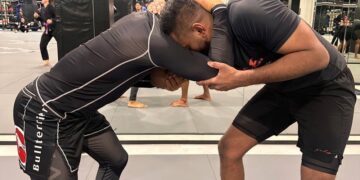
The Polish Throw is often used in mixed martial arts because of how often combatants find themselves in clinch positions. It is an outside trip that requires you to line up perpendicularly to your opponent before tripping or throwing them to the canvas.
Also known as the knee block throw or the step around body throw, the technique resembles a variation of Judo throws like the Ura Nae or Kosoto Gake.
The most common position to execute a Polish throw in mixed martial arts is a body lock or the over-under clinch position. One of the reasons the technique has become popular in mixed martial arts is because of how easy it is for people with limited grappling knowledge to master.
The variations that involve throwing your opponent over your back are quite a sight to behold. It’s a great way to get a crowd behind you.
Mastering The Polish Throw For Mixed Martial Arts
The polish throw is easy to learn since it can be broken down into a few crucial steps. The first step is the setup, which refers to how you start the technique and the grips you use. The second step is the step around, where you attempt to trap your opponent’s leg. The mechanics vary based on which variation of the polish throw you’re executing.
The last step is the throw, which can be done in different ways based on your opponent’s reaction and how you plan to follow up.
Some of the commonly used setups to perform a Polish throw in MMA include:
1) The Two-On-One Arm Drag
You can quickly enter this setup from an over-under clinch position. The arm drag opens up the gap you will enter with your step around. You can easily transition to a body lock after establishing this position to control your opponent’s body more.
2) The Two-On-One Russian Tie
There are various ways to enter the Polish throw from the Russian tie. One way is to release your grip around your opponent’s wrist as you shoot in for an underhook. Another way is to switch your wrist hold and fold the arm toward you as you pull your opponent straight to prevent them from pulling away from you.
3) The Over-Under Clinch
The over-under clinch is the most commonly used setup for the Polish throw in MMA because fighters often end up clinched up with each other during a fight. You can execute it from the over-under or transition to a body lock to open your options. The tripping variations of the Polish throw typically work best from the over-under clinch.
Securing a body lock makes it more challenging for your opponents to escape your attempt at a Polish throw, and it can also be used to trap your opponent’s hand.
4) The Whizzer
The Whizzer is another common way to set up a Polish throw. It is an overhook that’s used to control your opponent’s arm. It is commonly used to help defend against takedowns in grappling and mixed martial arts, but it also has offensive uses.
One way to perform a Polish throw using a whizzer is to pull up your opponent with a whizzer as they shoot in for a takedown. Doing so puts you in a position to secure a body lock while your opponent’s base is unbalanced. Another way to perform a polish throw is to wrap your opponent with double overhooks when they clinch up with you before performing the throw.
The Step Around
Now that we’ve gone over some of the more popular entries for the Polish throw let’s explore how you position yourself for the throw with a step around.
The step around before the throw makes it easier to trap your opponent’s leg as you get into the starting position. It also allows you to adjust as needed so your hips are always close to your opponent.
You don’t need to look to step in as deep as possible when performing a Polish throw. Stepping in too far or wide can even be detrimental to the technique, depending on the variation you’re performing. You want to step in or around just enough to keep your hips close to your opponent so you can load them up before executing the technique. Doing so makes it easier to throw your opponent while protecting you against counters like headlocks.
Keep your weight well distributed once you’ve stepped in since leaning can leave you vulnerable to being countered. The principle behind the Polish throw is much like the bridge and roll mount bottom escape used in Brazilian Jiu-Jitsu. The idea is to trap your opponent’s hand and then roll them in that direction.
Try to make it a habit to look for body locks when stepping in. Being closer to your opponent makes it easier to wrap your hands around them, giving you much more control, especially if you can trap an arm.
The Throw
Now that we’ve gone over how to set up the Polish throw and step into it, it’s time to go over the most crucial part: the takedown or throw.
It’s often best to start with the trip variations of the Polish throw since it’s a great way to master the technique and build confidence before moving on to the variation that involves throwing your opponent.
One of the most straightforward tripping variations of the Polish throw involves blocking your opponent’s ankle with your leg while you pull them over it.
The high amplitude version of the technique involves pulling your opponent in with a body lock before loading them on your hips and launching them over your shoulders.
Here’s the breakdown of the different steps:
- Get into one of the many entry points for the technique. The key to executing the technique is having solid control of your opponent’s body. You ideally want to secure a body lock from whatever clinch position you choose to start the technique from.
- Step around to one of your opponent’s sides so your body is now perpendicular to theirs, meaning you are squared up facing one of their sides, while their torso is front-facing.
- Trap the leg closest to you to trip your opponent to the ground as you lean back toward the side you’re taking them. You can also bring your opponent to your hips, pick them off the canvas, and throw them to the canvas.
You may also like:
Do You Have What It Takes To Be An MMA Fighter?
Fighters often find themselves in the overtie position in mixed martial arts and grappling-based fighting styles like Brazilian Jiu-Jitsu and Wrestling. Two combatants are in the overtie position when both fighters have one hand on…
Attacking and defending from different angles is a key aspect of MMA. When two fighters square off, they are in a fifty-fifty situation, with both of their centerlines facing each other. This leaves both fighters…
So you want to be a fighter? Learning effective techniques you can use inside a cage is only half of the equation when it comes to mixed martial arts. How much power you have or…
As you delve into the grappling world of Brazilian Jiu-Jitsu (BJJ) and Mixed Martial Arts (MMA), you’ll find the Gable Grip (also known as the Gable Clasp) to be an invaluable tool in your arsenal. …
Punching is an integral part of any combat sport, whether it’s Boxing, Kickboxing, Muay Thai, or MMA. The ability to land powerful punches is essential for any combat athlete. Even if you are primarily a…
Striking is an essential aspect of another MMA fighter’s arsenal. Although grappling is a powerful tool, all MMA fights start with both fighters standing facing each other. Even a skilled, veteran grappler needs some competency…
Every BJJ student worldwide should aim to become proficient in using their favored techniques. The art of Brazilian Jiu-Jitsu is filled with many amazing techniques, and one person’s game can vary significantly from another, even…
The pendulum step in boxing is a back-and-forth, rhythmic step that is mostly used at the amateur level. Some professional boxers also use the movement, but it’s not as common at the higher levels due…
The cartwheel kick was a unique and innovative technique that became extremely popular in Muay Thai in the early 2000s. Though it has since been banned in professional competition it is still an incredibly fun…
There are different ways to pass the guard in BJJ. Some grapplers prefer to pass while standing, kneeling, and utilizing speed or pressure-based passes. Another strategy is by forcing the opponents into certain positions like…
Boxing is an intense martial art that improves your physical and mental well-being. It gives you a full-body workout that engages every muscle in your body, and it forces your heart and lungs to work…
We all know that being a new parent is one of the most challenging things you’ll ever do. Your little bundle of joy needs a lot of tender loving care, and the more help, the…


































